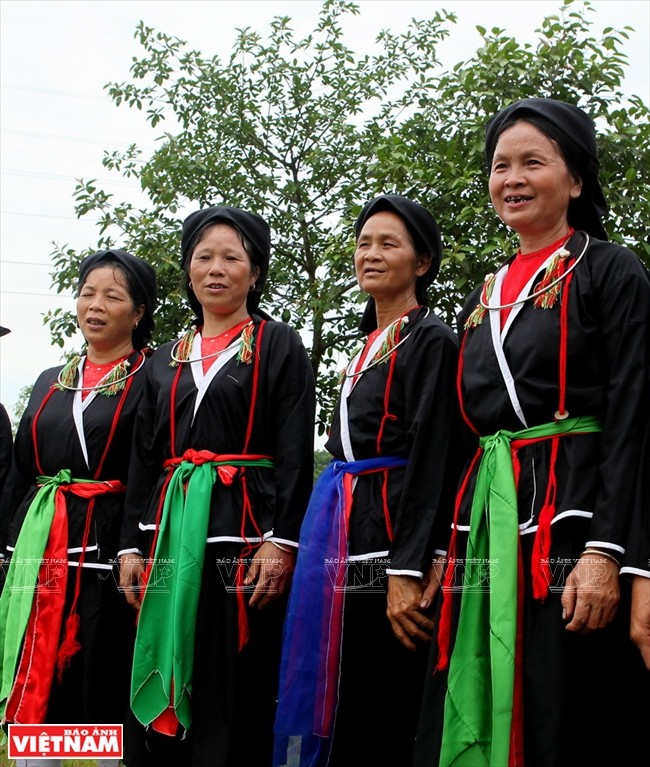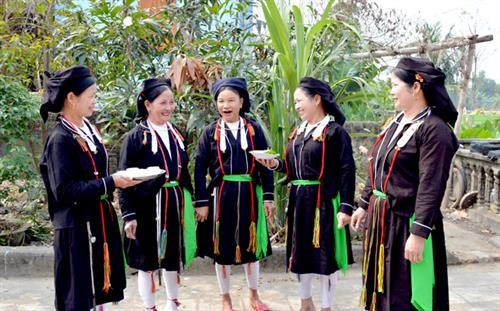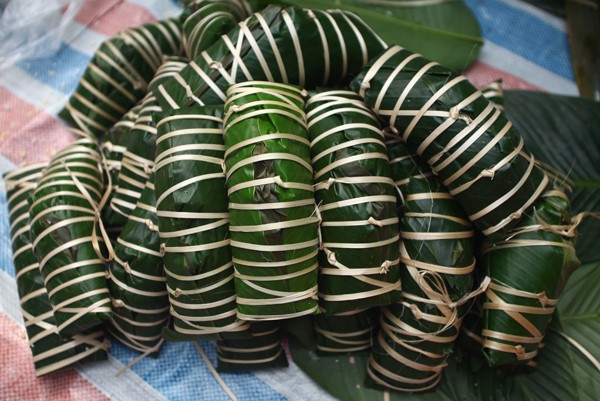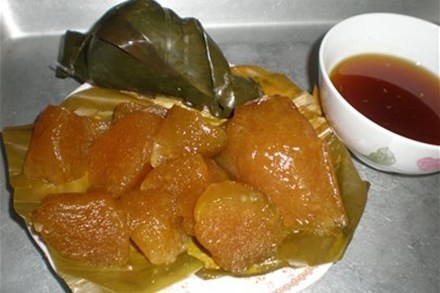(VOVWORLD) - The San Diu ethnic minority people, believed to have migrated from Guangdong, China in 1600, are now living in villages in Vietnam’s northern midlands and mountainous areas. The San Diu are also known as San Deo, Trai, Trai Dat and Man Quan Coc.
Traditionally, San Diu ethnic women make their own clothes. A piece of traditional clothing often takes several months to complete. Diep Thi Vong from Vinh Phuc province is one of a few San Diu women keeping the tradition of making her own clothes and teaches the younger generation how to weave and embroider.
“My grandmother and mother used to make their own clothes. They taught me and even sent me to a weaving class to learn how to make San Diu traditional clothes. A San Diu woman was required to make what she wore on her first day of marriage,” Mrs. Vong said.
 San Diu women in their traditional clothes. (Photo: vietnam.vnanet.vn) San Diu women in their traditional clothes. (Photo: vietnam.vnanet.vn) |
San Diu women often layer their clothes — a traditional white top inside and an indigo black light jacket outside. Young women secure their jacket with a green or red belt, right side over left while older women do it the other way around. The highlight of the San Diu’s traditional women’s clothes is the skirt made up of two to four separate pieces of clothes of different kinds. These pieces are tied to the waist line to make it look like a skirt. They decorate the skirt with a belt of colorful threads. San Diu’s traditional clothes do not feature patterns, only the traditional top is embroidered in a simple manner.
San Diu women and men often sing “soong co” while they are working in the fields as a way to ease the difficulty of the work. Sọong cô, a kind of duet singing, honors the beauty of the homeland and labor, patriotism, and confesses love.
“We sing soong co indoors, when the hosts sing to welcome guests from other villages. We also sing soong co outdoors when groups of men and women meet at a market, for example. On weddings, the groom’s family and the bride’s family exchange soong co tunes. Some sessions last until midnight or till the next morning. Single men and women sing soong co to get to know each other,” said Luu Van Nam, the President of a local soong co singing club in Vinh Phuc province.
 San Diu women sing soong co. (Photo: dantocmiennui.vn) San Diu women sing soong co. (Photo: dantocmiennui.vn) |
On Thanh Hoa and Lam Thi Ly fell in love with the other’s soong co singing and ended up marrying each other. They call soong co their “matchmaker”.
“We met at a wedding and approached the other with our gentle and warm soong co singing voice. We then traveled to other villages to sing soong co and gradually fell in love with each other. We dated then asked our parents to approve our marriage,” Mr. Hoa elaborated.
The couple has been married for nearly 40 years. Despite lots of ups and downs, Hoa and Ly said they never forget how soong co connected them and made them soul mates. A soong co song is a poem of four sentences with seven words each written in Chinese and passed orally. San Diu people not only sing soong co to each other but also teach younger generations to preserve the folk tunes. Soong co is still popular in many regions with the San Diu people as many soong co singing clubs have been founded to develop this unique singing practice.
“Our club was established in 2013 with 30 members and now has 50 members. There are two classes where we teach soong co to young children to preserve this culture,” said the soong co singing club President Luu Van Nam.
For Lam Thi Ly, teaching her grandchildren soong co is a life-long passion. She said, “I’m very passionate about this volunteer job. The children go to school on week days so I often gather them at my house on weekends or special occasions to teach them every sentence and every song. My youngest student is 3 and the oldest is 12.”
Luu Thi Tam expressed her joy at learning soong co: “Young people like me have so many things to learn in today’s modern world and sometimes ignore the traditions. I want to contribute to preserving the culture.”
San Diu people believe a human has two parts: body and soul. A healthy person means his/her body and soul are closely associated while a sick or dead person shows the separation of his/her body and soul. The soul of a dead person is distributed into three parts: the first one goes to heaven, the second one stays in the altar of his/her family, and the last part resides in hell. They also believe that dead people still need to live a full life in the afterlife.
San Diu people carry out worshipping rituals not on the death anniversary of their ancestors but on special occasions when they need their ancestors’ blessings. The head or the son of the family hosts the worshipping ritual. For families having a young son or no son, a shaman will host the ritual. On occasions such as the traditional lunar new year festival, the Mid-autumn festival, or the New Rice festival, the San Diu people offer their ancestors incense and a full meal. Sticky rice cakes and tro cakes made of glutinous rice flour dipped in tree ashes and lime are two must-haves in each and every meal offered to the ancestors.
 San Diu ethnic people's traditional square cakes. (Photo: VOV) San Diu ethnic people's traditional square cakes. (Photo: VOV) |
A square cake wrapped with layers of dong leaves and chit leaves symbolizes the solidarity of a community. The cake is tied with seven to nine knots representing the number of generations who are closely connected. It’s wrapped manually without a frame.
“Unlike the sticky rice cakes known for their square shape, our traditional cakes have a top which represents our ancestors granting blessings to the descendants. A cake must be wrapped tightly and carefully to ensure its quality,” Mrs. Ly said.
 A tro cake takes hours to complete. (Photo:ngaynay.vn) A tro cake takes hours to complete. (Photo:ngaynay.vn) |
A tro cake, about 150 to 200g each, is wrapped with chit leaves in the similar shape of the sticky rice cake. Then it’s boiled within 8 to 10 hours, got rest. Both cakes represent the sophistications and patience of the San Diu ethnic people.
“For tro cakes, we burn lychee and longan trees to ashes, mix these ashes with a little lime and water. We dip high quality rice and bamboo shoot in the water of that mixture overnight and start to make the cake the next day,” Mrs. Ly added.